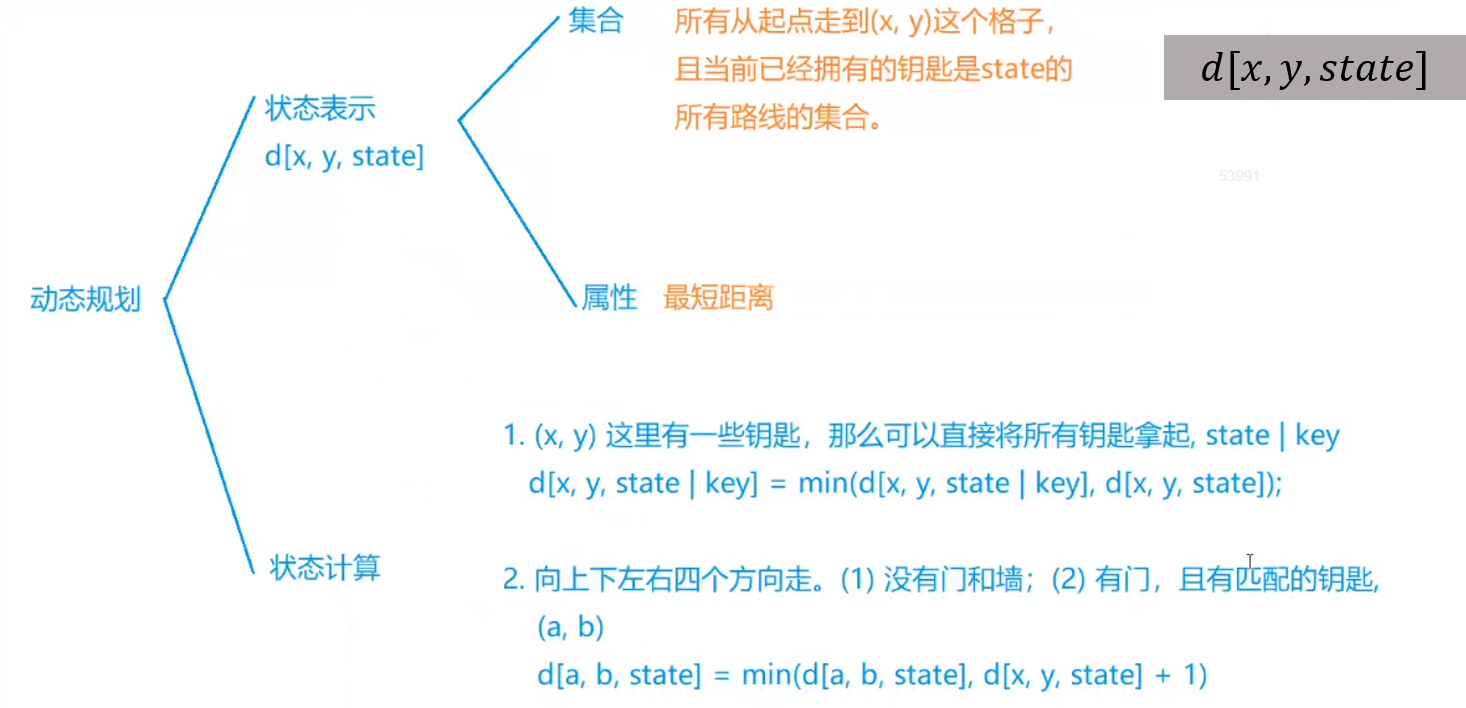类比于动态规划,使用d[x, y, state]表示的含义以及状态计算如下所示:

然而,这里的状态之间存在循环依赖(不存在拓扑序),比如对于迷宫中的位置[1, 3]与[1, 4],它们之间由于不存在门而可以相互进入,则[1, 3, state]与[1, 4, state]之间就相互依赖,而导致无法计算。因此,本题不能用动态规划的方法来计算,而要转化成最短路问题来求解。
若要转化成最短路问题,关键是如何建图。根据上图中状态计算的分类,可通过如下方式建图:
- 将状态计算中的第1种情况看作是在
[x, y, state]与[x, y, state | key]之间建立起一条边权为0的边; - 将状态计算种的第2种情况看作是在
[x, y, state]与[a, b, state]之间建立起一条边权为1的边;
补充知识点:
DP与最短路之间存在密切的联系,即DP问题可看作是拓扑图上的最短路问题,也就是说,如果存在拓扑序,最短路问题是可以用DP的方法来计算的,同样地,如果不存在拓扑序,则无法采用DP的方法来计算,而要类比成最短路问题来求解。
注意:为了简化代码,下面的代码中将方格[x, y]映射成一个整数,存储在g数组。
import java.util.*;
public class Main
{
static int N = 12, M = N * N, P = N, E = 400, INF = 0x3f3f3f3f;
static int[] h = new int[M];
static int[] e = new int[E];
static int[] ne = new int[E];
static int[] w = new int[E];
static int idx;
static int n, m, p;
static int[][] g = new int[N][N]; // 左上角(1, 1)对应图中编号为1的节点,节点编号从左到右、从上往下依序递增
static int[] key = new int[M]; // key[x]表示图中编号为x的节点处,所拥有钥匙的状态(状态压缩)
static int[][] d = new int[M][1 << P]; // d[id][state]表示从起点(即id=1)出发到id这个位置、所持钥匙状态是state时的最短路径
static LinkedList<int[]> q = new LinkedList<>(); // 存储的是[id, state],id表示图中节点编号,state表示所持钥匙的状态
static boolean[][] st = new boolean[M][1 << P]; // 用于双端队列bfs,类似于dijkstra里的用于判断是否添加到集合中的数组
static HashSet<String> edges = new HashSet<>(); // 存储添加了哪些边,图中节点编号3和7之间的边记作为“3 7”,其它情形类似
static int[] dx = {-1, 1, 0, 0}, dy = {0, 0, -1, 1};
public static void add(int a, int b, int c)
{
e[idx] = b;
ne[idx] = h[a];
w[idx] = c; // 存储的是门的类型
h[a] = idx ++;
}
public static void build()
{
for(int i = 1; i <= n; i ++)
for(int j = 1; j <= m; j ++)
for(int u = 0; u < 4; u ++)
{
int nx = i + dx[u], ny = j + dy[u];
if(nx <= 0 || nx > n || ny <= 0 || ny > m) continue;
StringBuilder e_sb = new StringBuilder();
e_sb.append(g[i][j] + " " + g[nx][ny]);
if(!edges.contains(e_sb.toString()))
{
add(g[i][j], g[nx][ny], 0);
edges.add(e_sb.toString());
}
}
}
public static int bfs()
{
// 初始化d数组
for(int i = 0; i < M; i ++) Arrays.fill(d[i], INF);
// 初始化起点
d[1][0] = 0;
q.addLast(new int[]{1, 0});
while(!q.isEmpty())
{
int[] t = q.removeFirst();
if(st[t[0]][t[1]]) continue;
st[t[0]][t[1]] = true;
if(t[0] == n * m) return d[t[0]][t[1]];
// 若有钥匙,则拿钥匙
if(key[t[0]] != 0)
{
int nstate = t[1] | key[t[0]];
d[t[0]][nstate] = Math.min(d[t[0]][t[1]], d[t[0]][nstate]);
q.addFirst(new int[]{t[0], nstate});
}
// 向着四周(上下左右)转移
for(int i = h[t[0]]; i != -1; i = ne[i])
{
int j = e[i];
// 走不过去则跳过
if(w[i] != 0 && (t[1] >> w[i] & 1) == 0) continue;
// 可走过去
if(d[j][t[1]] > d[t[0]][t[1]] + 1)
{
d[j][t[1]] = d[t[0]][t[1]] + 1;
q.addLast(new int[]{j, t[1]});
}
}
}
return -1;
}
public static void main(String[] args)
{
Arrays.fill(h, -1);
Scanner sc = new Scanner(System.in);
n = sc.nextInt();
m = sc.nextInt();
p = sc.nextInt();
// 初始化g数组
for(int i = 1, t = 1; i <= n; i ++)
for(int j = 1; j <= m; j ++)
g[i][j] = t ++;
// 建图
int k = sc.nextInt();
for(int i = 0; i < k; i ++)
{
int x1 = sc.nextInt(), y1 = sc.nextInt();
int x2 = sc.nextInt(), y2 = sc.nextInt();
int c = sc.nextInt();
// 不是墙,就创建一条路径
if(c != 0)
{
add(g[x1][y1], g[x2][y2], c);
add(g[x2][y2], g[x1][y1], c);
}
StringBuilder e_sb1 = new StringBuilder();
StringBuilder e_sb2 = new StringBuilder();
e_sb1.append(g[x1][y1] + " " + g[x2][y2]);
e_sb2.append(g[x2][y2] + " " + g[x1][y1]);
edges.add(e_sb1.toString());
edges.add(e_sb2.toString());
}
build();
// 读取钥匙,特别注意同一方格处可能存在多把钥匙
int s = sc.nextInt();
for(int i = 0; i < s; i ++)
{
int x = sc.nextInt(), y = sc.nextInt(), q = sc.nextInt();
key[g[x][y]] |= 1 << q;
}
// 利用双端队列bfs,求最短路的长度
System.out.println(bfs());
}
}

